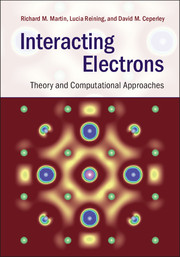Book contents
- Frontmatter
- Dedication
- Contents
- Preface
- Acknowledgments
- Notation
- Part I Interacting electrons: beyond the independent-particle picture
- Part II Foundations of theory for many-body systems
- Part III Many-body Green's function methods
- 9 Many-body perturbation theory: expansion in the interaction
- 10 Many-body perturbation theory via functional derivatives
- 11 The RPA and the GW approximation for the self-energy
- 12 GWA calculations in practice
- 13 GWA calculations: illustrative results
- 14 RPA and beyond: the Bethe–Salpeter equation
- 15 Beyond the GW approximation
- 16 Dynamical mean-field theory
- 17 Beyond the single-site approximation in DMFT
- 18 Solvers for embedded systems
- 19 Characteristic hamiltonians for solids with d and f states
- 20 Examples of calculations for solids with d and f states
- 21 Combining Green's functions approaches: an outlook
- Part IV Stochastic methods
- Part V Appendices
- References
- Index
21 - Combining Green's functions approaches: an outlook
from Part III - Many-body Green's function methods
Published online by Cambridge University Press: 05 June 2016
- Frontmatter
- Dedication
- Contents
- Preface
- Acknowledgments
- Notation
- Part I Interacting electrons: beyond the independent-particle picture
- Part II Foundations of theory for many-body systems
- Part III Many-body Green's function methods
- 9 Many-body perturbation theory: expansion in the interaction
- 10 Many-body perturbation theory via functional derivatives
- 11 The RPA and the GW approximation for the self-energy
- 12 GWA calculations in practice
- 13 GWA calculations: illustrative results
- 14 RPA and beyond: the Bethe–Salpeter equation
- 15 Beyond the GW approximation
- 16 Dynamical mean-field theory
- 17 Beyond the single-site approximation in DMFT
- 18 Solvers for embedded systems
- 19 Characteristic hamiltonians for solids with d and f states
- 20 Examples of calculations for solids with d and f states
- 21 Combining Green's functions approaches: an outlook
- Part IV Stochastic methods
- Part V Appendices
- References
- Index
Summary
Have no fear of perfection; you'll never reach it.
Marie CurieSummary
This chapter is devoted to the combination of many-body perturbation and dynamical mean-field approaches to build more powerful first-principles methods. The GWA and corresponding approximations to the Bethe–Salpeter equation are very successful for one-particle and optical spectra of materials, especially for delocalized states. Dynamical mean-field methods are a set of techniques using an auxiliary embedded system to treat interacting electrons in localized atomic-like states that lead to strong correlation and large temperature dependence due to low-energy excitations. The combination holds promise for feasible approaches to calculate spectra, correlation functions, thermodynamic properties, and many other properties for a wide range of materials.
In this chapter we return to the goal of robust first-principles methods that can treat materials and phenomena, such as the examples of Ch. 2: from covalent semiconductors like silicon to lanthanides with partially filled f shells like cerium; from optical properties in ionic materials like LiF to metal–insulator transitions in transition metal compounds, and much more. A natural approach is Green's function methods; however, it is very difficult to have one method that treats all cases. In fact, this is not the goal. We seek understanding as well as results. We seek combinations of methods that are each firmly rooted in fundamental theory, with the flexibility to take advantage of different capabilities and provide robust, illuminating predictions for the properties of materials.
This is an active area with on-going developments; the topics of this chapter are not meant to be exhaustive, but rather to formulate basic principles and indicators of possible paths for future work. The approach developed here can be used with any method that partitions a system into parts, treats the parts using techniques that may be different for the different parts, and then constructs the solution for the entire system. The formulation in terms of Green's functions, self-energies, and screened interactions is already given in Ch. 7; here we put this together with the practical methods developed in Chs. 9–20. If the procedures are judiciously chosen, the results have the potential to be more efficient, more accurate, and more instructive than a comparable calculation with a single method.
- Type
- Chapter
- Information
- Interacting ElectronsTheory and Computational Approaches, pp. 553 - 576Publisher: Cambridge University PressPrint publication year: 2016



